REGISTER WITH PAYPAL TUTORIAL (2/3): A Real Register with PayPal Project
Explain how PayPal works (IPN and PDT process). Chapter One Chapter Three
Key Takeaways
- The tutorial covers the process of setting up a PayPal account and integrating it with a registration form and database for a real project.
- The project involves creating a registration form, redirecting users to PayPal for payment, and implementing PayPal IPN as a backup plan in case users close their browser.
- The tutorial provides detailed instructions on setting up the database structure and user interface, creating a PayPal button, setting up a PayPal Sandbox account, and coding PDT and IPN handlers.
- The tutorial also answers frequently asked questions about registering for PayPal, including ensuring account security, registering without a credit card, benefits of a business account, and registering from outside the United States.
Chapter Two
This chapter introduces a real project: “registration with payment”, from start to end, for better explaining PayPal account setup and integration with register form and database.
Project Scenario
- First, we have a registration form.
- After completing the form correctly (all validation passed), user clicks on the ‘Register’ button.
- Then redirect to PayPal, user pay for the registration fee.
- After paid, PayPal will redirect to result page, and 10 seconds auto redirect back to our website, then PayPal PDT will process the payment record.
- But, user may close the browser, so we have to implement PayPal IPN for backup plan.
Database Structure
E-R Diagram:
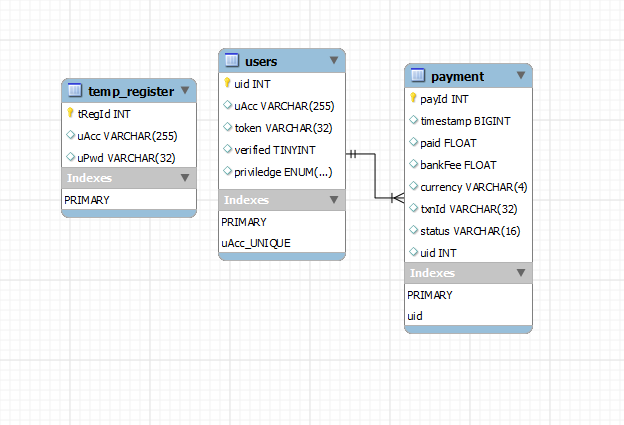
- temp_register table: temporary store user account and user password, wait for payment. If paid, the tuple will be deleted, and move to users table.
- payment table: uid is a foreign key referencing to users, to connect user information and payment information.
- users table: store users information, token is verification token in confirmation email. If user verified their user account, verified will be set as 1.
Database Schema:
CREATE TABLE IF NOT EXISTS `payment` (
`payId` int(11) NOT NULL AUTO_INCREMENT,
`timestamp` bigint(20) DEFAULT NULL,
`paid` float DEFAULT NULL COMMENT 'user paid amount returned by paypal',
`bankFee` float DEFAULT NULL,
`currency` varchar(4) DEFAULT NULL,
`txnId` varchar(32) DEFAULT NULL COMMENT 'Transaction ID: specify single unique transaction from paypal. if this field is NOT NULL, means this payment has been process already. So if IPN returns to PHP, we can refuse to update our database.',
`status` varchar(16) DEFAULT NULL,
`uid` int(11) DEFAULT NULL COMMENT 'FK to users PK',
PRIMARY KEY (`payId`),
KEY `uid` (`uid`)
) ENGINE=InnoDB DEFAULT CHARSET=latin1 AUTO_INCREMENT=1 ;
CREATE TABLE IF NOT EXISTS `temp_register` (
`tRegId` int(11) NOT NULL AUTO_INCREMENT,
`fullName` varchar(255) DEFAULT NULL,
`uAcc` varchar(255) DEFAULT NULL,
`uPwd` varchar(32) DEFAULT NULL,
PRIMARY KEY (`tRegId`)
) ENGINE=InnoDB DEFAULT CHARSET=latin1 COMMENT='prevent unpaid user take uAcc(UNIQUE) in our users table' AUTO_INCREMENT=1 ;
CREATE TABLE IF NOT EXISTS `users` (
`uid` int(11) NOT NULL AUTO_INCREMENT,
`fullName` varchar(255) DEFAULT NULL,
`uAcc` varchar(255) NOT NULL,
`uPwd` varchar(32) NOT NULL,
`token` varchar(32) DEFAULT NULL,
`verified` tinyint(1) NOT NULL DEFAULT '0',
`priviledge` enum('delegate','admin','developer') NOT NULL DEFAULT 'delegate',
PRIMARY KEY (`uid`)
) ENGINE=InnoDB DEFAULT CHARSET=latin1 AUTO_INCREMENT=1 ;
ALTER TABLE `payment`
ADD CONSTRAINT `payment_ibfk_1` FOREIGN KEY (`uid`) REFERENCES `users` (`uid`);User Interface

Project Workflow
- Fill the form, and all inputs are validated.
- Click Register button, redirect to PayPal.
- PayPal Sandbox ‘Pay Now’:
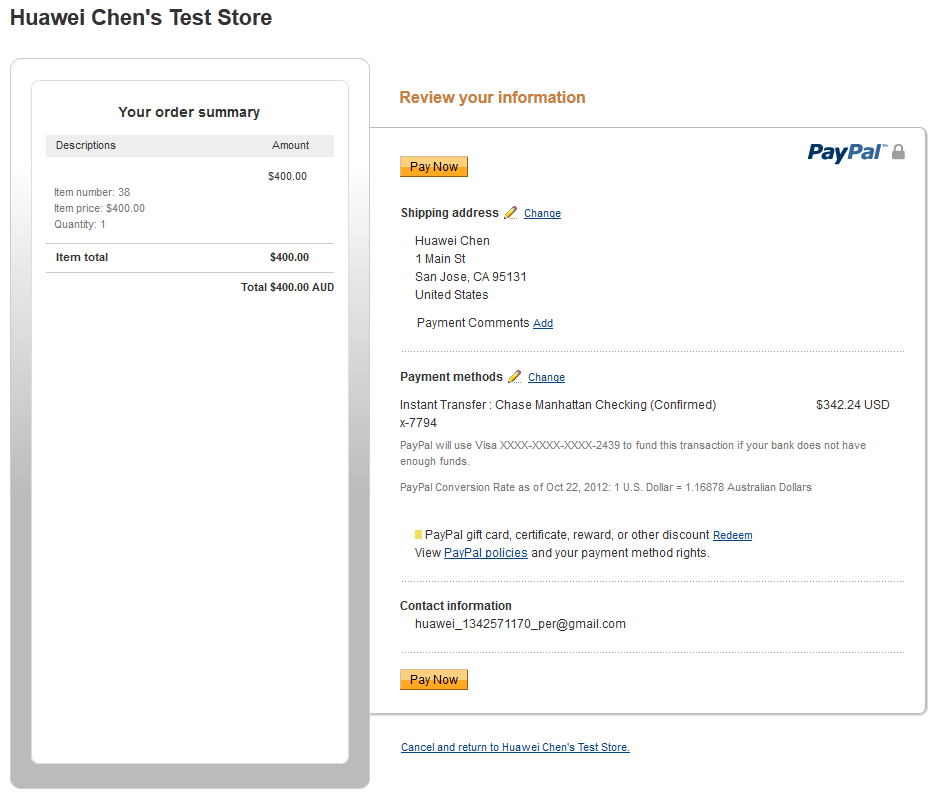
- Redirect PayPal result page.
- Wait for redirect (PDT works) show success/fail page, or close browser (IPN works).
Setup PayPal Sandbox
Before we start coding, we need to setup PayPal Sandbox account first.
Suppose you have registered a PayPal developer account, and have created one business user account and one buyer account in Sandbox.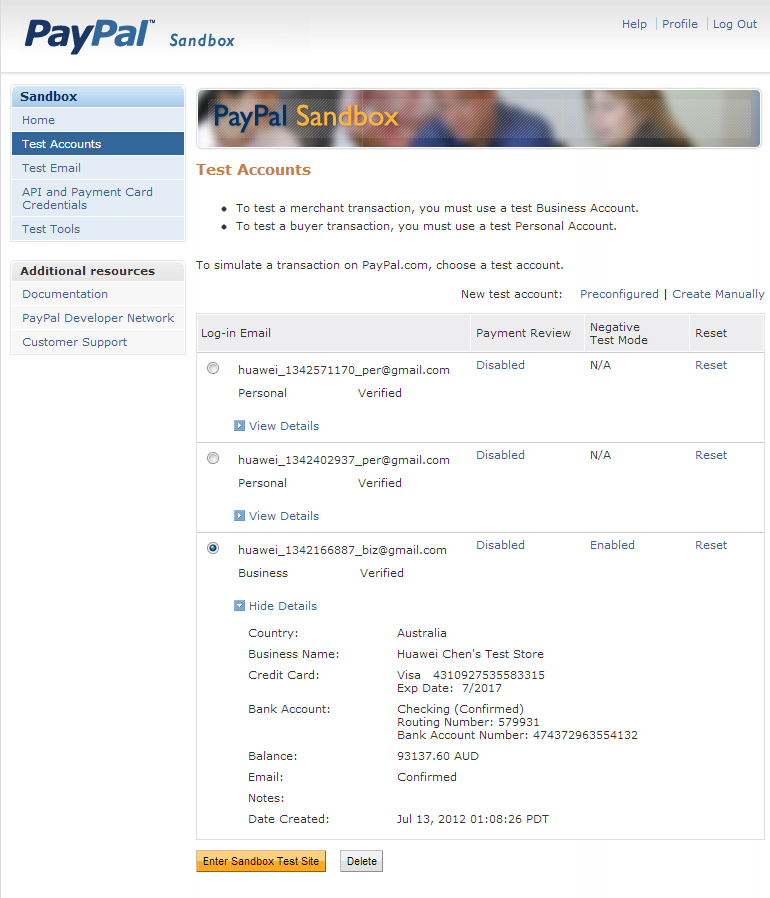
Then select business account, and click on the ‘Enter Sandbox Test Site’ Button.
You can see the main panel pop-out page:

Then you can see all information and selling preference settings.
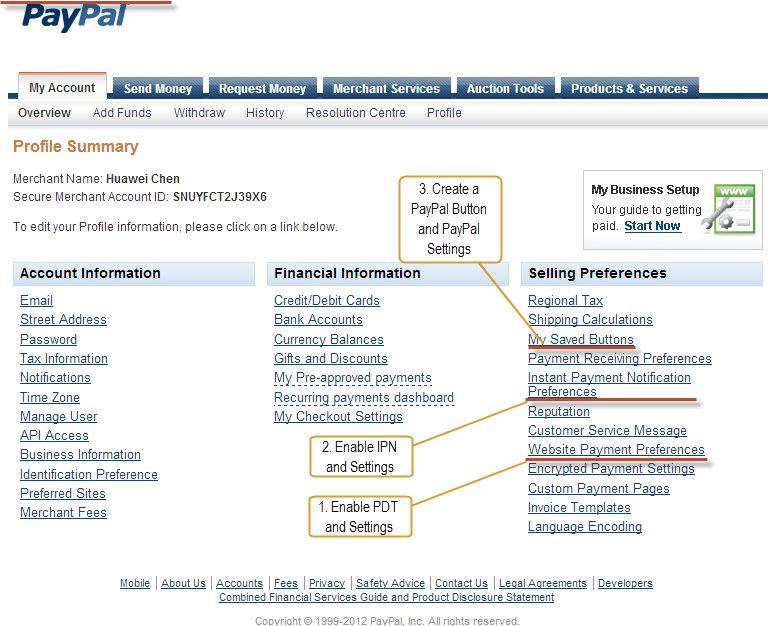
So let’s setup all the three options one by one in order.
1. Enable PDT and Settings
Setup your PDT handler function calling URL.
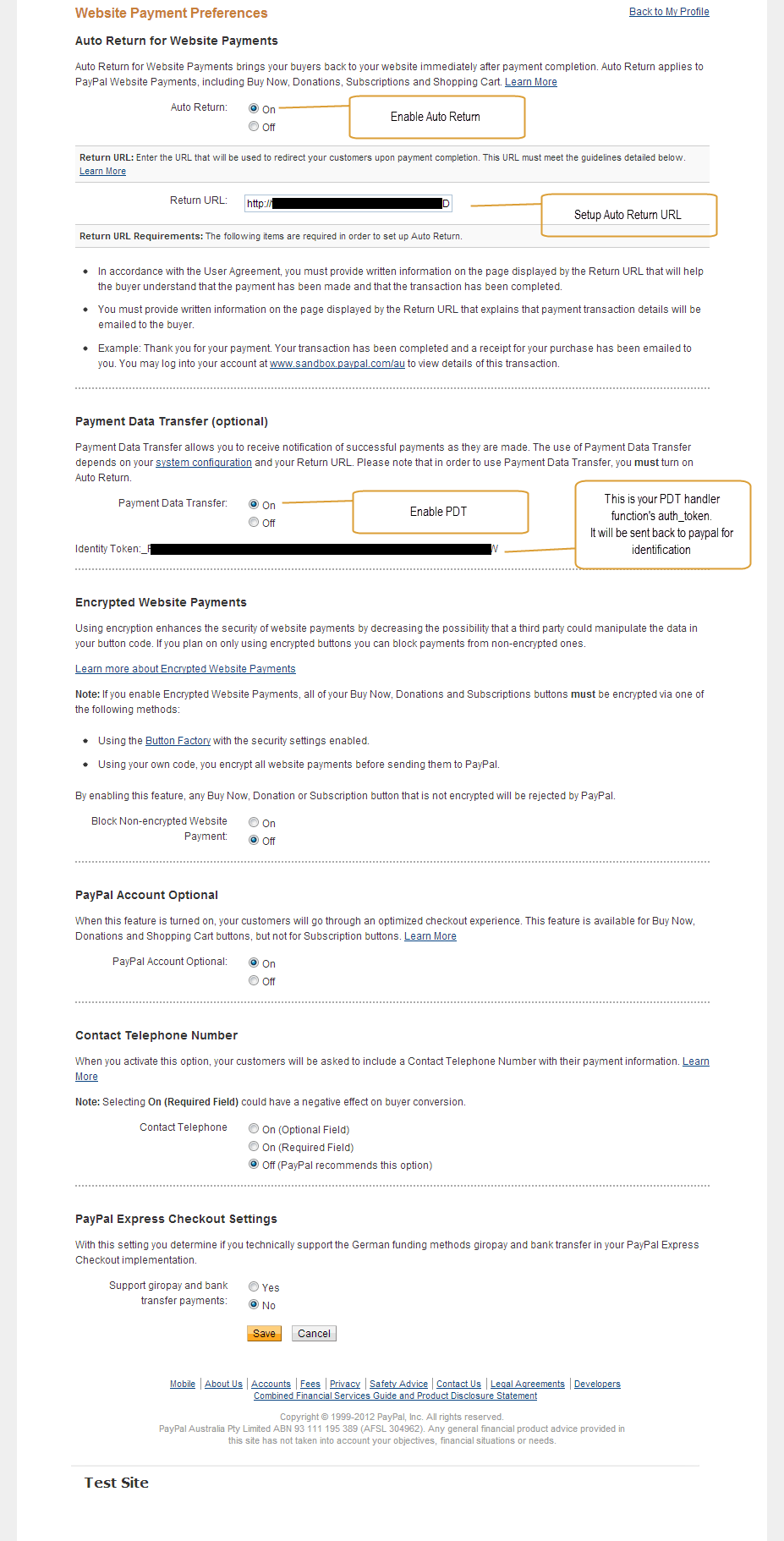
2. Enable IPN and Settings
Setup your IPN handler function calling URL.
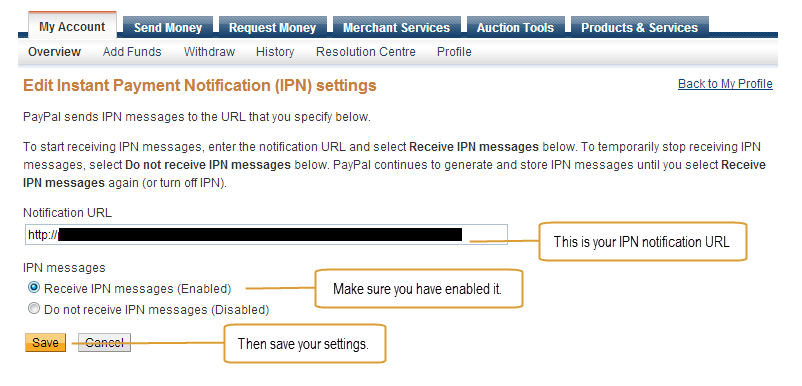
2. Create a PayPal Button and PayPal Parameter Settings
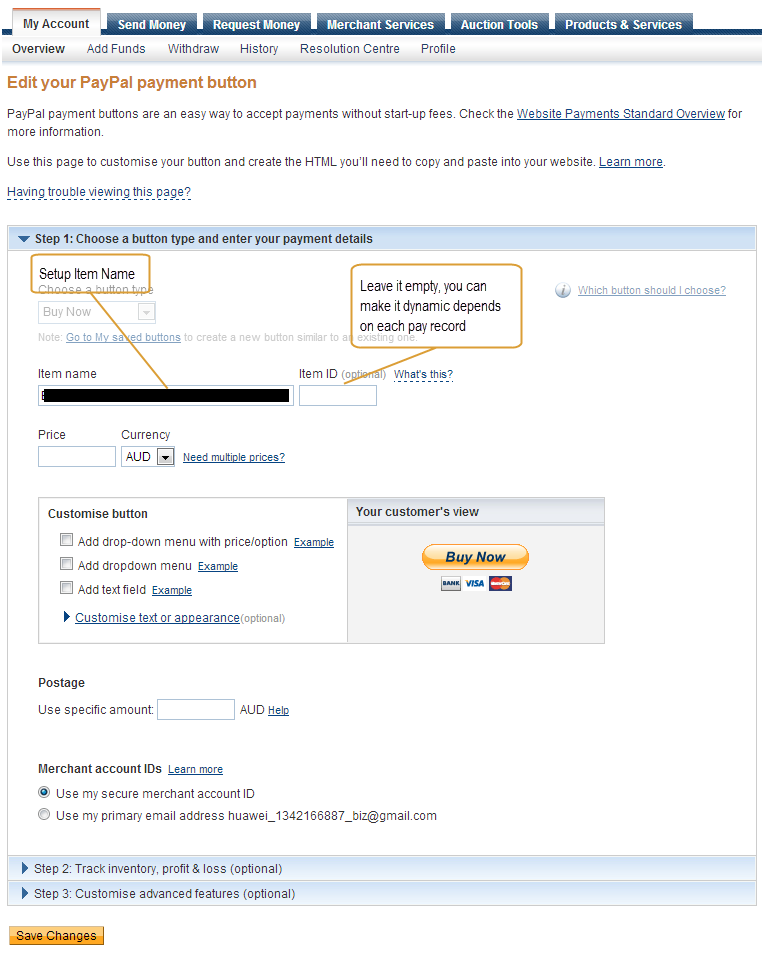
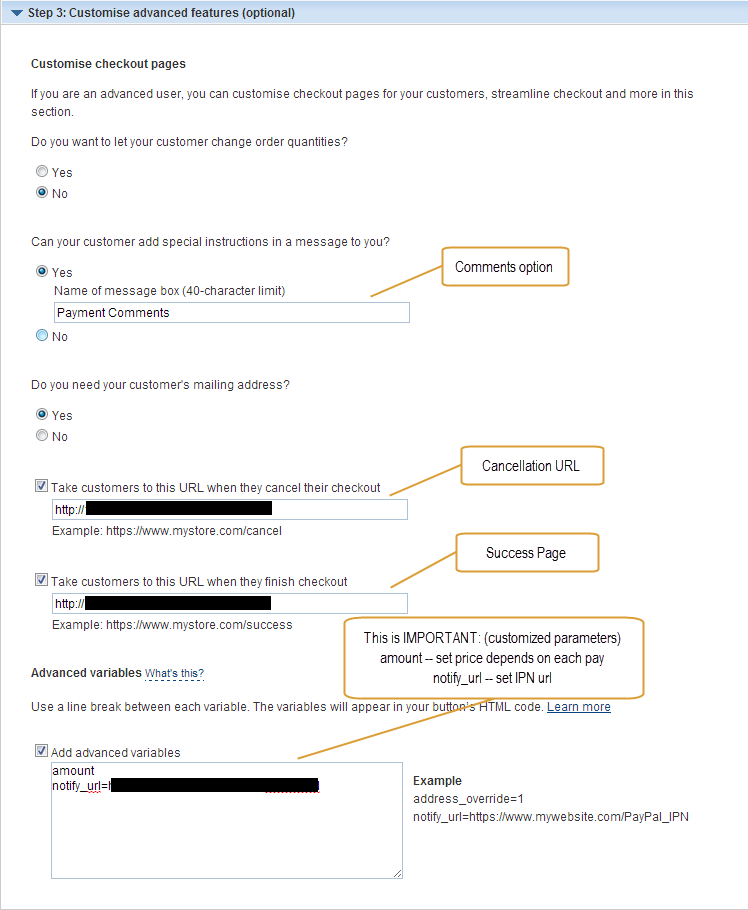
After you saving your change, you can see the source code of your PayPal Button:
It is easy to find out that the button is actually a form, so we need to POST data using its inputs.
When we generate our ‘register’ button, the redirect URL, should contain ‘&cmd=_s-xclick’ and ‘&hosted_button_id=HA9DZBCKXKCL2’.
Now, PayPal Sandbox account has been setup. Then start to code your PDT and IPN handlers.
PDT Handler Function
Source Code:
/**
* PAYPAL: PDT HANDLER:
* ====================
* called by PayPal, send tokens back
* get payment details and payment result
* @return $ret array contains result true/false, and user account or error message
*/
private function _PDT()
{
// some indexes can not be missing:
$ruler = array(
'tx', // token from paypal
);
if(count(array_diff($ruler, array_keys($_GET))))
{
return array('result' => false, 'error' => 'Index missing ... ', 'index' => $_GET, 'missing' => array_diff($ruler, array_keys($_GET)));
}
// read the post from PayPal system and add 'cmd'
$req = 'cmd=_notify-synch';
// get token and prepare request url (send back to paypal)
$tx_token = $_GET['tx'];$auth_token = "_PJaHiwRfwMmWzW-9nuPuSguYxC-1d9KpxaasaNANtIvyOcmqY6jXNkRmxW";
// $auth_token = "OxDenzKmrWPyEXU0YzIg2zs-VAe7ufCADyjbfxF_RpREL4rLEslZrSa21R4";
$req .= "&tx=$tx_token&at=$auth_token";
// post back to PayPal system to validate
$header = "POST /cgi-bin/webscr HTTP/1.0rn";
$header .= "Host: www.sandbox.paypal.comrn";
// $header .= "Host: www.paypal.comrn";
$header .= "Content-Type: application/x-www-form-urlencodedrn";
$header .= "Content-Length: " . strlen($req) . "rnrn";
$fp = fsockopen ('ssl://www.sandbox.paypal.com', 443, $errno, $errstr, 30); // open socket
// $fp = fsockopen ('ssl://www.paypal.com', 443, $errno, $errstr, 30); // open socket
if (!$fp)
{
// HTML FAIL
return array('result' => false, 'error' => 'HTTP error ... ');
}
else
{
fputs ($fp, $header . $req);
// read the body data
$res = '';
$headerdone = false;
while (!feof($fp))
{
$line = fgets ($fp, 1024);
if (strcmp($line, "rn") == 0)
{
$headerdone = true; // read the header
}
else if ($headerdone)
{
$res .= $line; // header has been read. now read the contents
}
}
// parse the data
$lines = explode("n", $res);
$keyarray = array();
if (strcmp ($lines[0], "SUCCESS") == 0)
{
for ($i=1; $i_validatePaypal($keyarray);
}
// log for manual investigation
else if (strcmp ($lines[0], "FAIL") == 0)
{
// skipped
return array('result' => false, 'error' => 'Transaction failed ... ');
}
}
fclose ($fp);
return $ret;
}Explanation:
PayPal call PDTHandler() function, then this handler function process _PDT(). As you see, it receives parameters provided by PayPal, from the URL ($_GET). So we POST token and tx back to PayPal, via fsock ssl. Then PayPal will return payment record, and payment result (SUCCESS/FAIL). _PDT() passes those data to _validatePaypal() which saves data into database. Then, page redirect according to the return.
IPN Handler Function
Source Code:
/**
* PAYPAL: IPN HANDLER:
* ====================
* called by PayPal, send POSTed payment data back (handshake)
* get payment result
* return: payment VERIFIED: array('result' => true/false, and other user details)
* payment INVALID: false // no further process (see handler in Register Module)
* TODO: return true if success, then send email to buyers
*/
private function _IPN()
{
// get IPN data
$postData = $_POST;// read the post from PayPal system and add 'cmd'
$req = 'cmd=' . urlencode('_notify-validate');
foreach ($postData as $key => $value) {
$value = urlencode(stripslashes($value));
$req .= "&$key=$value";
}
// CURL: copy from paypal sample code
$url= 'https://www.sandbox.paypal.com/cgi-bin/webscr';
// $url= 'https://www.paypal.com/cgi-bin/webscr';
$curl_result=$curl_err='';
$ch = curl_init();
curl_setopt($ch, CURLOPT_URL, $url);
curl_setopt($ch, CURLOPT_RETURNTRANSFER, 1);
curl_setopt($ch, CURLOPT_POST, 1);
curl_setopt($ch, CURLOPT_POSTFIELDS, $req);
curl_setopt($ch, CURLOPT_HTTPHEADER, array("Content-Type: application/x-www-form-urlencoded", "Content-Length: " . strlen($req)));
curl_setopt($ch, CURLOPT_HEADER , array('Host: www.sandbox.paypal.com'));
// curl_setopt($ch, CURLOPT_HEADER , array('Host: www.paypal.com'));
curl_setopt($ch, CURLOPT_VERBOSE, 1);
curl_setopt($ch, CURLOPT_SSL_VERIFYPEER, FALSE);
curl_setopt($ch, CURLOPT_TIMEOUT, 30);
$res = @curl_exec($ch);
$curl_err = curl_error($ch);
curl_close($ch);
$keyarray = $postData;
if (strcmp (substr($res, '-8'), "VERIFIED") == 0)
{
// validate paypal information
return $this->_validatePaypal($keyarray);
}
elseif (strcmp (substr($res, '-7'), "INVALID") == 0)
{
// log for manual investigation
return false;
}
// return $ret; // Do not need to return, because IPN runs in background
}Explanation:
PayPal call IPNHandler() function, then this handler function process _ IPN (). As you see, it receives data provided by PayPal, from the request ($_POST). So we POST payment details back to PayPal, via cURL, this is the handshake process. Then PayPal send back payment result (VERIFIED/INVALID). If it’s verified, _IPN() passes those data to _validatePaypal() which saves data into database.
In the zip file, it contains templates, javascript files, css, bootstrap, jquery, debug plugin and smarty plugin, and all core php source code.
Frequently Asked Questions about Registering for PayPal
How can I ensure my PayPal account is secure during registration?
Security is a top priority when setting up a PayPal account. To ensure your account is secure, use a strong, unique password that includes a mix of letters, numbers, and special characters. Also, make sure to provide accurate personal information during registration. PayPal uses this information to verify your identity and protect your account from fraudulent activities.
Can I register for a PayPal account without a credit card?
Yes, you can register for a PayPal account without a credit card. During the registration process, you can choose to link a bank account instead of a credit card. However, linking a credit card can provide additional payment options and security features.
What are the benefits of registering for a PayPal business account over a personal account?
A PayPal business account offers several benefits over a personal account. These include the ability to accept payments from customers, access to business loans and cash advances, and the option to create and send invoices. A business account also allows you to operate under a company or group name.
How can I register for a PayPal account if I live outside the United States?
PayPal is available in more than 200 countries and regions around the world. To register for a PayPal account outside the United States, visit the PayPal website for your specific country or region. The registration process is similar to that in the United States.
What information do I need to provide when registering for a PayPal account?
When registering for a PayPal account, you will need to provide your legal name, address, phone number, and email address. You will also need to create a password and choose two security questions to help protect your account.
How long does it take to register for a PayPal account?
The registration process for a PayPal account is quick and easy. It typically takes just a few minutes to complete. However, it may take a few days for PayPal to verify your bank account or credit card information.
Can I register for more than one PayPal account?
Yes, you can register for more than one PayPal account. However, each account must have a unique email address and financial information. You can have one Personal account and one Business account.
What happens if I forget my PayPal password during registration?
If you forget your PayPal password during registration, you can reset it by clicking on the “Forgot your password?” link on the login page. You will then be prompted to enter your email address, and PayPal will send you an email with instructions on how to reset your password.
Can I change the information I provided during PayPal registration?
Yes, you can change the information you provided during PayPal registration. To do this, log in to your PayPal account, go to your Profile, and select the information you want to change.
Is there a fee to register for a PayPal account?
No, there is no fee to register for a PayPal account. However, PayPal does charge fees for certain transactions, such as receiving payments for goods and services or sending money to another country.
Sam Deering has 15+ years of programming and website development experience. He was a website consultant at Console, ABC News, Flight Centre, Sapient Nitro, and the QLD Government and runs a tech blog with over 1 million views per month. Currently, Sam is the Founder of Crypto News, Australia.
Published in
·AngularJS·APIs·APIs·Authentication·CMS & Frameworks·Frameworks·JavaScript·Laravel·Patterns & Practices·PHP·Security·February 19, 2016





